The History of our Raven Inn
Aka The History, Social History and Landscape Archaeology of the Raven Inn, Glazebury, Cheshire
The Raven Inn was put up for sale in 2019 for demolition and redevelopment. The advertising for the planned development included the lure: “Built on the site of the historic Raven Inn”.
This plan was, frankly, devastating for the local community who loved the landmark, its history and its once thriving environment. An action group was set up on Facebook to ‘Save the Raven’, which over the next three years attracted 1000 supporters.
The first inkling that the Raven Inn was on the site of an ancient structure came when Facebook member, Arizonian historian Van Hostetler, identified that a ‘five furlong spacing’ existed between the medieval halls in a chain of halls along the Glaze Brook. The site of the Raven fell on a spacing between Holcroft Hall and Hurst Hall, which Van considered significant, alerting the ‘Save the Raven’ action group. This is the remarkable nature of the internet – an historian 5,000 miles from the inn could join the fight and participate on an equal footing with the local community.
Intrigued, scientist and amateur historian Bob Eden responded to a request from the ‘Save the Raven’ action group to investigate this ‘strange’ claim of Van’s. He did, with some initial scepticism, and it was the beginning of a trans-Atlantic collaboration lasting to this day.
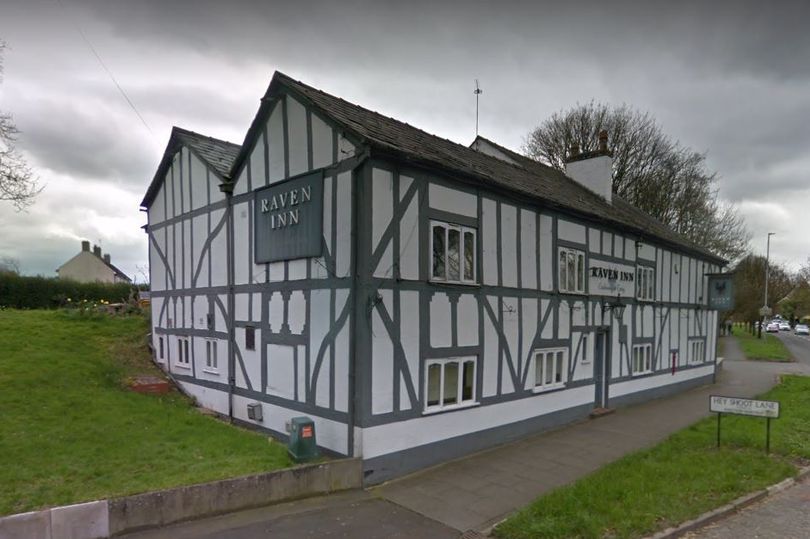

Medieval Period

This layout is perhaps the ‘metes and bounds’ survey relating to the division of Gilbert’s estate.
Also from this point, a line to Light Oaks Hall and then 90degrees to Hurst Hall is 730m along each line. The line from Light Oaks Hall crosses the Glaze at its mid-point over Light Oaks bridge, which had sufficient bearing capacity to carry the weight of a hay wain and horses, adding to the likelihood of this interpretation of careful laying-out.
The track following the line to Holcroft today is known as Hey Shoot Lane, probably taking its name from middle English and French for the ‘high chute’ (as in water chute), namely the tailrace of the mill. Perhaps the track in the other direction over Fowley Common to Hurst Hall was the Lowe Shoot Lane? But this is conjecture.

Here is one such mill reference from 1275:
In the year of our Lord one thousand twelve hundred and seventy-five on Saturday on the morrow of the Invention of the Holly Cross at Thorneton this agreement was made between Dame Cecilia de Lawton on the one part and Richard de Culchit/gentleman/ on the other. Namely that the foresaid Dame Cecilia leases and demises a third part of the mills of Culchit which she has in the name of dower in the same for the term of her life to the foresaid Richard de Culchit /gentleman/ for twelve shillings of money paid to her annually at two terms of the year namely at the Nativity of Saint John the Baptist six shillings and at the Nativity of our Lord six shillings. And the foresaid Dame Cecilia has granted that all the tenants in the township of Culchit shall do suit at the foresaid mills and similarly that the said Richard is to construct a new pond and mills as was customary in the time of Gilbert de Culchit. And the foresaid Dame Cecilia has the right to grind her own corn in the foresaid mills. (And continues by stating what happens if the rent is not paid etc together with the sealing and witness clause).
Tudor Period
Waterpower to the mill was augmented with additional water through the construction of a shallow gradient ‘contour leat’ connecting the Jibcroft Brook to the Twiss Brook through Fowley Common. Delivery of water from the Fowley Common Leat across the trackway (which is now Warrington Road) to the Twiss Brook was controlled by a sluice gate.
The ‘Fowley Common Leat’ was perhaps dug at the time the medieval watermill was upgraded to brickwork, and if this was the case the upgrade took place in Tudor times.


In 1544 Thomas Shagh took a 60-year lease on the mill, and during his tenancy the much larger nearby Culcheth Corn Mill was constructed on the Glaze Brook serving the three halls.
Either by design or dint of circumstance, the mill on the Raven site was repurposed as the Raven Inn. When this change of use took place is unknown, but local lore cites 1562 (so perhaps Thomas was the first landlord?) A good enough date (and celebrant). And another perhaps: ‘Shagh’ was the given name of Shaw Street, which runs to Newchurch, Culcheth.
Below Van Hostetler created an impression of Thomas Shagh’s Tudor mill building. Because of the significant volume of surviving fabric, the dimensions of the walls are as measured and not guesswork. Based on Tudor examples the location of the and size of the mill gear is conjecture.
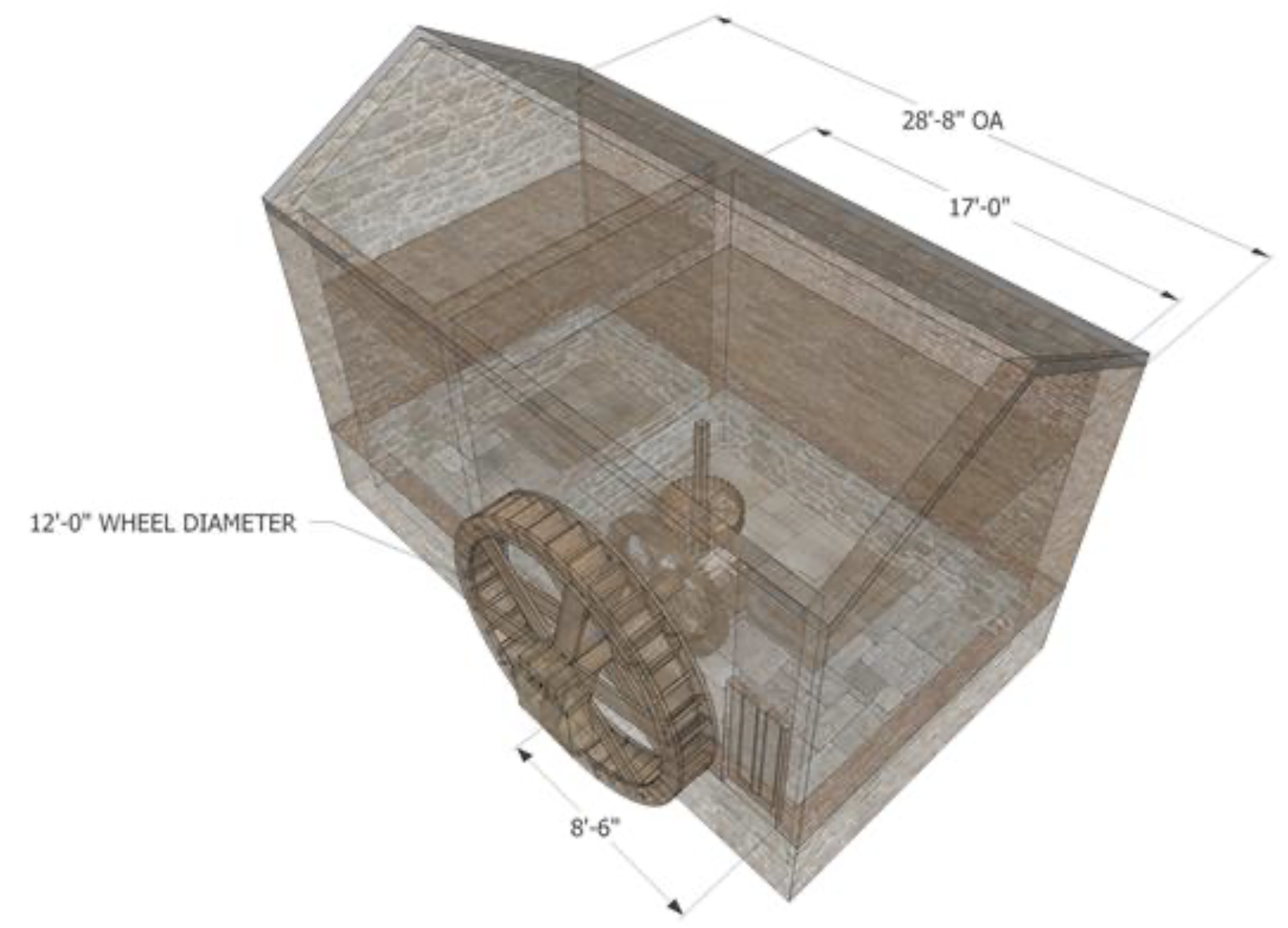
The English Civil War
In 1650 an historically important Holcroft marriage took place at New Church, Culcheth. Through his friend Captain Thomas Holcroft, the ‘dashing’ Irishman 34-year-old Captain Thomas Blood caught the attention of 17-year-old Marie Holcroft, daughter of the head of the family Lieutenant Colonel John Holcroft of Holcroft Hall. Her father was not happy, but the couple married at New Church in Culcheth.
In September 1651 two thousand defeated Scots from the Battle of Worcester escaped north. They were harassed and picked-off along the way. Five hundred Scots crossed the River Mersey at Hollin Ferry and following the track just west of the Glaze Brook traversed the next obstacle, Jibcroft Brook, five miles north at the Raven Inn, where Parliamentarians John and Thomas Holcroft held control.
The Scots were deep in Parliamentarian territory, and alerted to the troop movements, Holcroft, and his men ambushed them from land adjacent to the Raven. Given the imbalance of troop numbers, the ambush was probably more than at arm’s length and engaged with musket and small cannon fire. In 1905 a ‘Minion’ canon ball was found at nearby Moss House Farm (if from Fowley Common, it was fired at point blank range) and in 2019 several musket balls were detected opposite the Raven by detectorist Sean Holcroft(!) The 3” diameter ball is on display in Warrington Museum, but without evidence local lore has it that in the fusillade Scottish soldiers were killed and buried at that site.
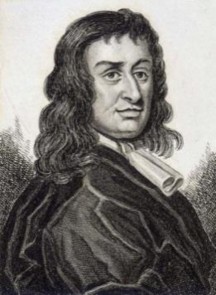
Because the Raven Inn was later described in 1770 as ‘ancient’, it is more than likely that Captains Holcroft and Blood frequented the Raven for their ale. No doubt they discussed Blood’s and Marie’s marriage plans and later celebrated the Scottish harassment, which became a skirmish, a rout and then, in local lore and perhaps even to Holcroft’s ‘best’ recollection, a full-blown battle.
But that wasn’t the end of Thomas Blood’s story. He remained a military man, rising to the self-appointed rank of Colonel, and with Marie hatched ‘a dashing plan’ to steal the Crown Jewels. In 1671 the news of the attempted, but failed theft, would have reached the Raven Inn. Surprisingly, he was not hanged for this crime, and perhaps the only thing of Blood’s that was hung was his portrait.
Blood become the tale of legend; no doubt polished to perfection by Blood’s in-laws, and whose historical presence we can raise a glass in the building where we stand and toast him today. Slaintѐ!
The Georgian Era
The Holcrofts held the family seat into the late C17th century by when the Tyldesley family had married into and controlled the Holcroft estate. But come the mid C18th, debt was consuming the Tyldesleys and land and resource were put up for auction and sold.
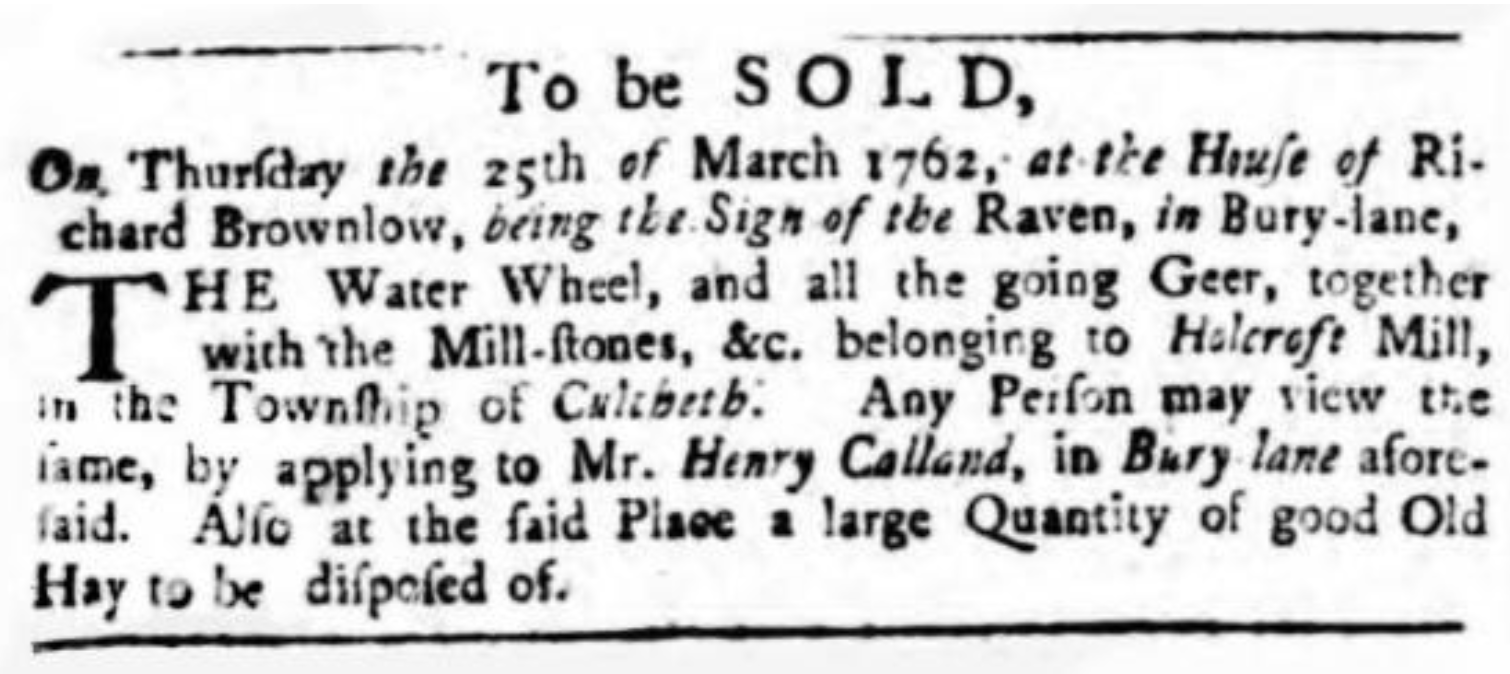
The Raven Inn served as an auction house and ‘The Water Wheel, and all the going Geer’ from the Holcroft Hall (which had operated its own, later, mill) was sold there in March of 1762.
In July 1762 Holcroft land was auctioned at the Eagle and Child Inn, Warrington. In July 1770, the Tyldesleys sold “...the ancient hostelry, the Raven Inn...” and other properties to John Lyon, and the hall itself was put up for rent in October 1771.
Today, Lyon’s name is borne by the house, ‘Lion’s Den’, on the corner of Warrington Road and Holcroft Lane. In earlier years, Lyon Lane was given to that part of Warrington Road running into Culcheth from Holcroft Lane and Bury Lane that part from Holcroft Lane past the Raven Inn to Glazebury.
When Blood’s exploits were romanticised at the turn of the last century by the Reverend Wittenbury-Kaye, a Manchester clergyman and antiquarian, he claimed in his book that the de Culcheth arms of the Eagle and Child was originally used for the Raven Inn sign.
From successive repairs and paint touch-up, the image morphed into what eventually looked like a Raven atop the body of a corpse (a dead Scottish soldier, representing defeat at the ‘Battle’ at the Raven). Wittenbury-Kaye wrote (I paraphrase) “...out of common decency the body was eventually overpainted leaving just a Raven”. Even the reference to ‘Bury’ Lane was hijacked by Wittenbury-Kaye, being ‘evidence’ of the Scottish burial ground adjacent to the Raven Inn.
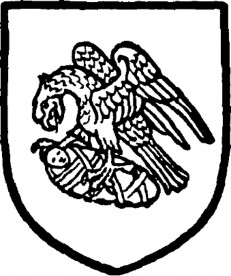
The Victorian Era
In the early C19th an east wing was added, and by the mid C19th the roof of the Tudor building was raised to the same elevation to provide commercial accommodation. These building works created the unusual double-gabled end we see today. The ‘Good Stabling’ advertised on the original brickwork of the Raven dates from the turn of the last century when John Clough was the landlord.
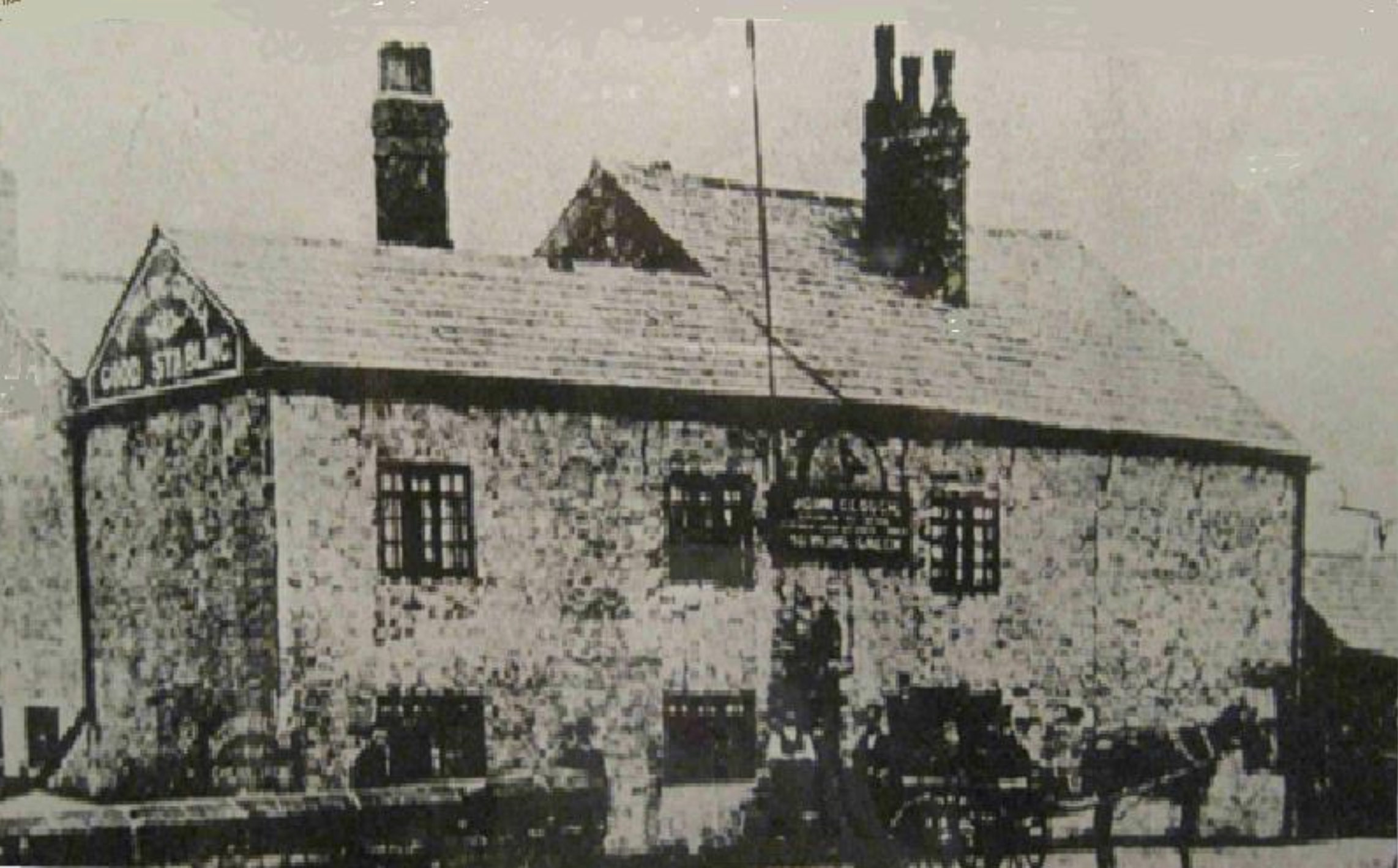
In the C19th the Raven building was also host to the local Coroners’ Court where enquiries into suspicious and accidental deaths were held, and it was from the public records that the next story was discovered.
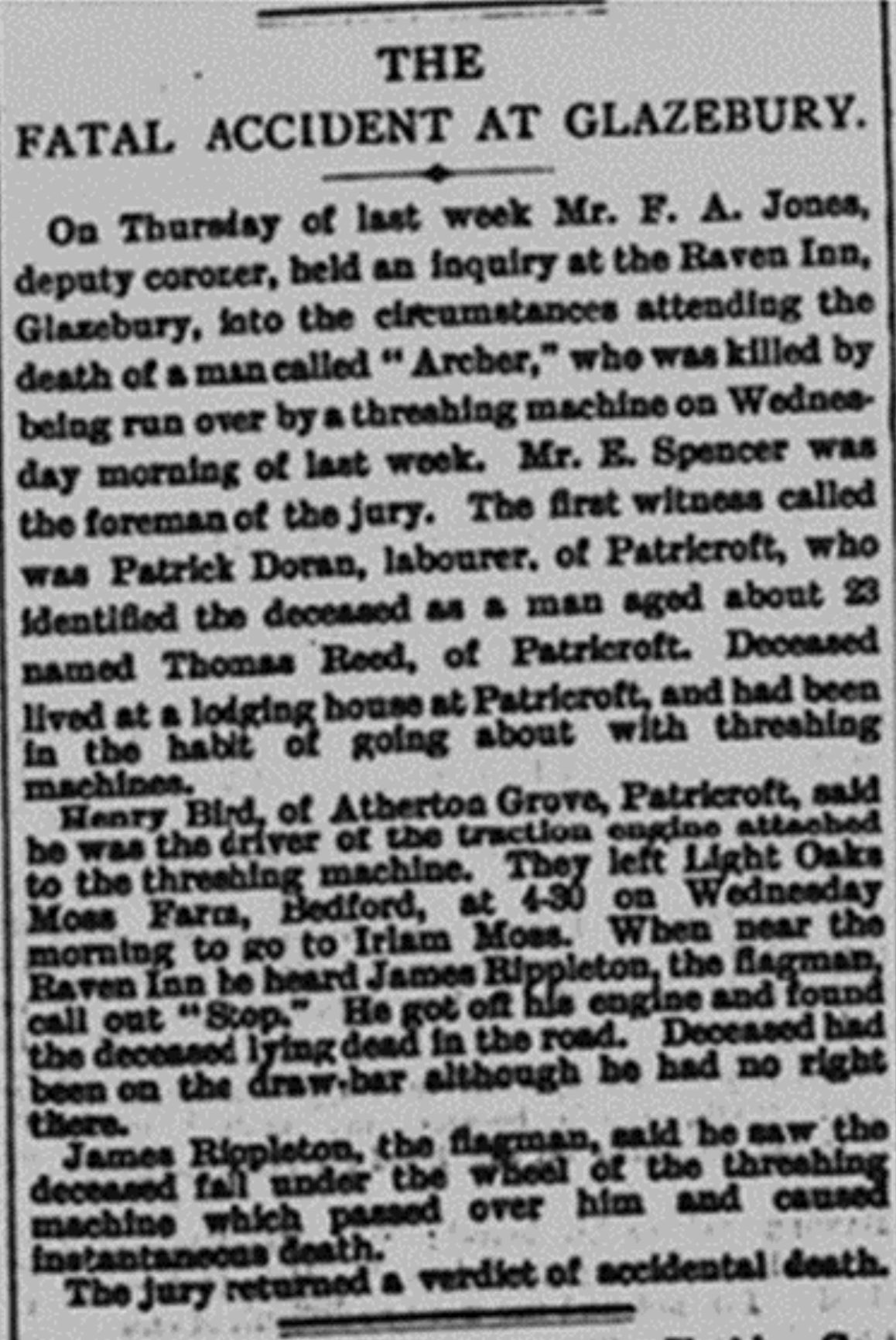
In 1893, a young farm labourer, Archer, was riding the drawbar of a steam traction engine towing a threshing machine from the Chat Moss to Irlam Moss. Crossing the Jibcroft Brook at the inn Archer slipped from the drawbar and was severed in two halves lengthways by the steel tyre of the threshing machine. His two body halves were taken into the Raven.
At the time of the accident, the young man’s name was unknown. He was identified to the deputy coroner as 23-year-old Thomas Reed. The deputy coroner bluntly declared Archer to be at fault and the verdict of the jury was accidental death.
The central role the Raven Inn played in the Victorian community was further underpinned by the social groups established during this time, including, for example, ‘The Raven Inn (Glazebury) Horticultural Society’ established in the 1870s and running well into the C20th. Although, not quite, a tongue twister, today ‘The Raven Diggers’ would be a less intimidating-sounding group to join.
The Modern Era
By the beginning of the C20th the pubs along Bury Lane were competing for passing trade and ‘Publicans’ rustic’ was adopted, to make the interiors and exteriors twee, creating a homely ‘olde worlde’ look.
Both the Raven Inn and the George and Dragon covered up their true brickwork exteriors; the Raven with stucco, a cement, sand and lime render shaped into fake timbers and bolt heads, and the George and Dragon concealed its brickwork with planks, dowels and render.
From a landmark perspective, the Raven wins this transformation hands-down. Maybe a co-incidence, but Wittenbury-Kaye’s book came out at this time; perhaps a concerted effort with the publican to create a mystique around the Raven? “More beer vicar...?”
In 2019, plans were discovered by the local community that the owners wanted the Raven Inn demolished for redevelopment. The ‘Save the Raven’ action group was founded by Maureen (Moe) Parkinson and Carole (Tufty) Watson. The team grew and was shortly joined by Peter Sturman as Chair of the group; a peaceful protest was organised.
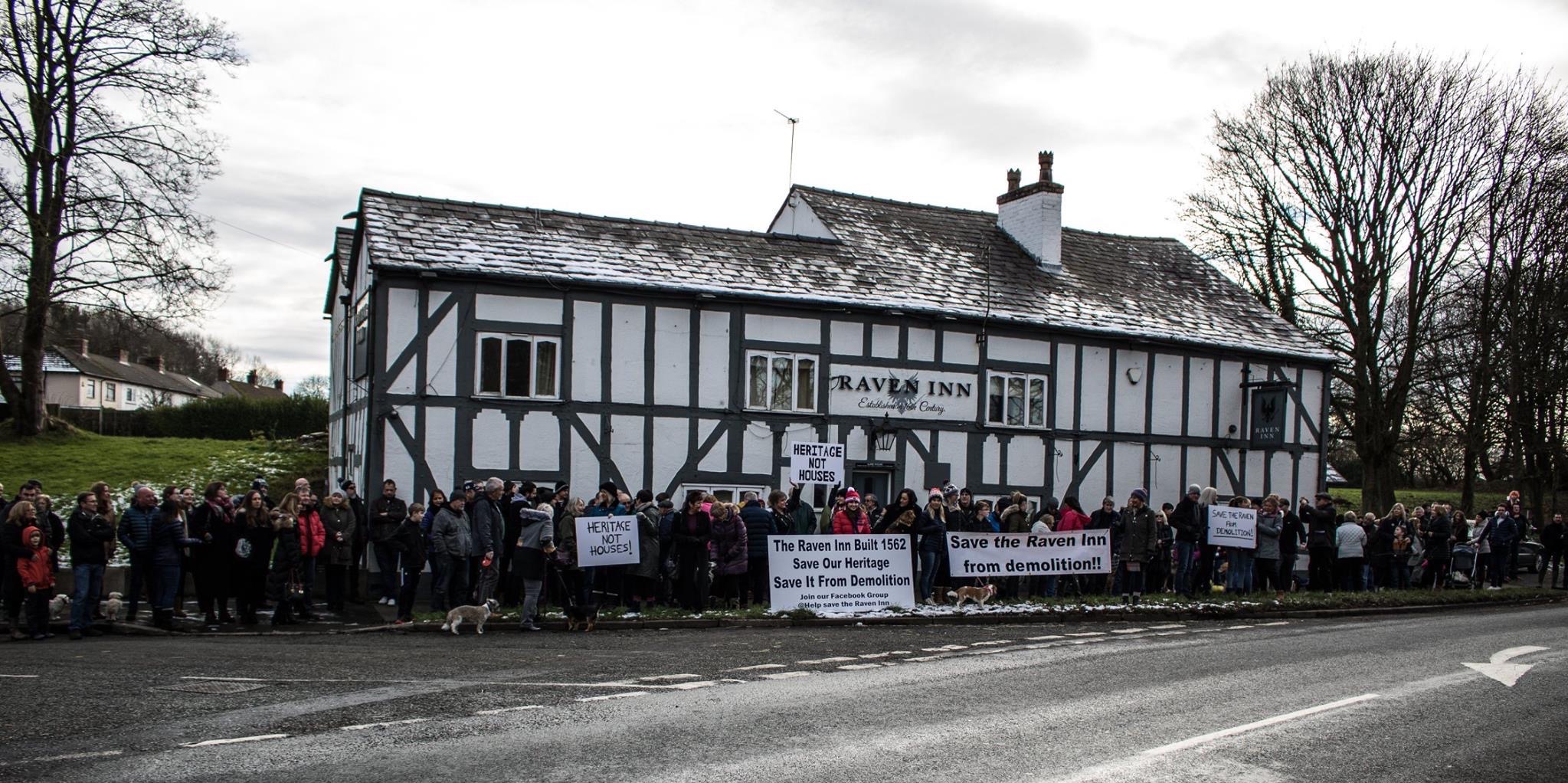
Three applications to Historic England to list and protect the Raven Inn were made. The first by Sue Leather, a fouth-generation farmer of the Marshall family who have supported the Raven Inn since the Second World War. The application for Grade II listing was turned down because of the faux timbers.
The next two applications were submitted by the historians of the ‘Save the Raven’ action group, with progressively ever more detailed research, but were again turned down because of the faux timbers. The rich and unfolding history of the building counted for nothing.
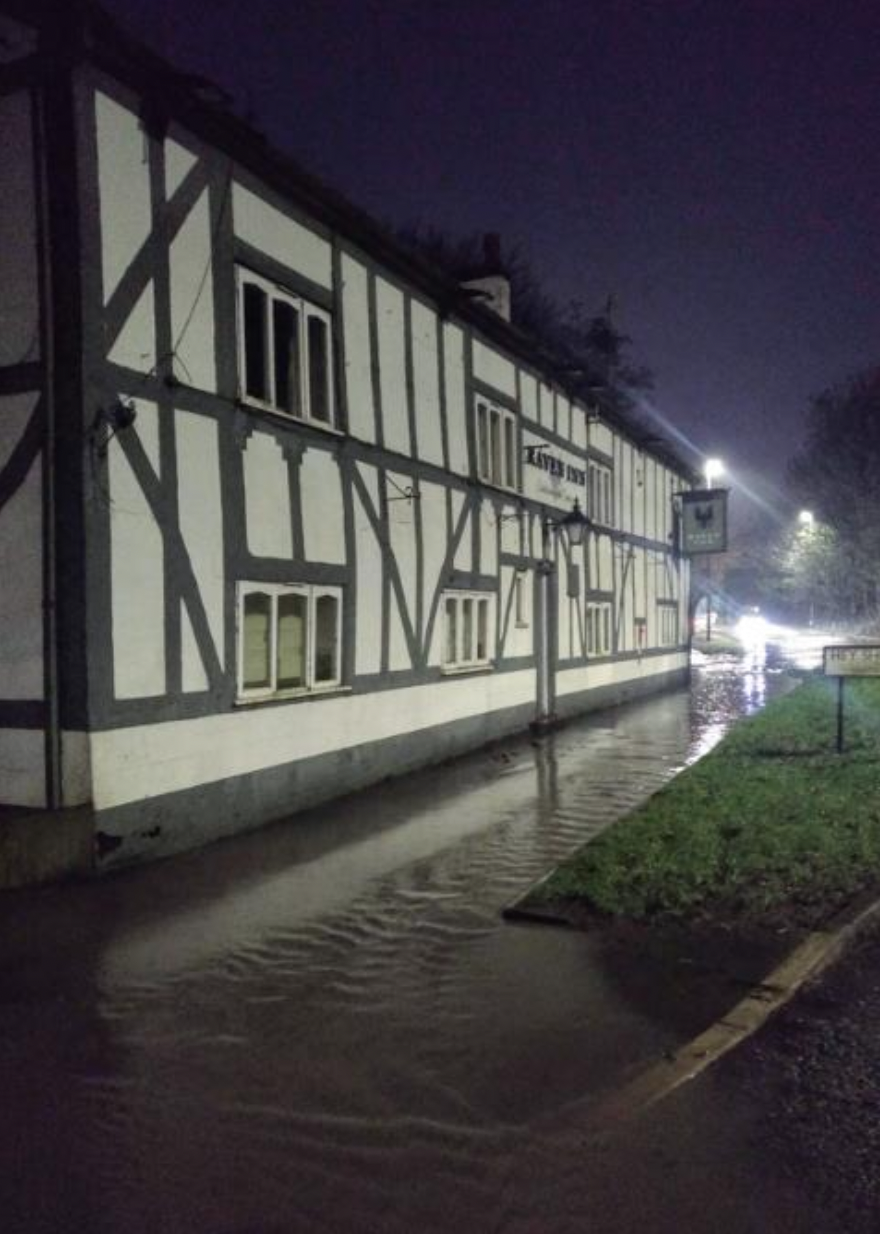
Since access to the Raven to identify internal features worthy of listing was denied by the owners, the history of the site alone was deemed as insufficient for protection by Historic England. The ‘Save the Raven’ group had to challenge the threat from developers without the reassurance of a Grade II listing, and the fight continued.
Storm Christoph struck in January 2021 causing severe flooding around but not within the Raven. The flooding was extensive, and the old headrace and tail race were revealed by water that would in yesteryear have been carried in the Twiss Brook forced its way overland to the Jibcroft Brook.
In the background, can we just make out the ghostly figure of Colonel Blood overseeing this spectacle...?
And moving to Halloween 2021, the Warrington Guardian ran a story claiming the Raven as one of the five most haunted pubs in Warrington. The Guardian reported that a local psychic had exorcised the Raven Inn in 1999 after a series of unexplained happenings; objects would often move, and cutlery would crash to the floor in the clichéd ‘middle of the night’. The psychic believed that there were two spirits in the pub, a man and a woman from the Georgian era. He insisted that there was nothing evil lurking there – explaining the female ghost was upset over people taking her job behind the bar.
The developers did not eventually acquire the Raven. The fight was successful, and the Raven remains standing. At the end of March 2022, the inn was bought at auction as a Community Hub for refurbishment. Considerable internal vandalism and metal theft has left the building in need of complete renovation. This has, however, given the new owners the opportunity to conduct an archaeological dig inside the inn and gain access to, and to expose and preserve, the important architectural features.
All text courtesy of Bob Eden